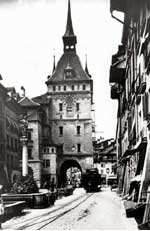Albert Einstein: The Great Works
A storm broke loose in my mind.

March 1905
Einstein sent to the Annalen der Physik, the leading German physics journal, a paper with a new understanding of the structure of light. He argued that light can act as though it consists of discrete, independent particles of energy, in some ways like the particles of a gas. A few years before, Max Planck’s work had contained the first suggestion of a discreteness in energy, but Einstein went far beyond this. His revolutionary proposal seemed to contradict the universally accepted theory that light consists of smoothly oscillating electromagnetic waves. But Einstein showed that light quanta, as he called the particles of energy, could help to explain phenomena being studied by experimental physicists. For example, he made clear how light ejects electrons from metals.
When the Special Theory of Relativity began to germinate in me, I was visited by all sorts of nervous conflicts... I used to go away for weeks in a state of confusion.
May 1905
The Annalen der Physik received another paper from Einstein. The well-known kinetic energy theory explained heat as an effect of the ceaseless agitated motion of atoms; Einstein proposed a way to put the theory to a new and crucial experimental test. If tiny but visible particles were suspended in a liquid, he said, the irregular bombardment by the liquid's invisible atoms should cause the suspended particles to carry out a random jittering dance. Just such a random dance of microscopic particles had long since been observed by biologists (it was called “Brownian motion,” an unsolved mystery). Now Einstein had explained the motion in detail. He had reinforced the kinetic theory, and he had created a powerful new tool for studying the movement of atoms.

June 1905
Einstein sent the Annalen der Physik a paper on electromagnetism and motion. Since the time of Galileo and Newton, physicists had known that laboratory measurements of mechanical processes could never show any difference between an apparatus at rest and an apparatus moving at constant speed in a straight line. Objects behave the same way on a uniformly moving ship as on a ship at the dock; this is called the Principle of Relativity. But according to the electromagnetic theory, developed by Maxwell and refined by Lorentz, light should not obey this principle. Their electromagnetic theory predicted that measurements on the velocity of light would show the effects of motion. Yet no such effect had been detected in any of the ingenious and delicate experiments that physicists had devised: the velocity of light did not vary.
Einstein had long been convinced that the Principle of Relativity must apply to all phenomena, mechanical or not. Now he found a way to show that this principle was compatible with electromagnetic theory after all. As Einstein later remarked, reconciling these seemingly incompatible ideas required “only” a new and more careful consideration of the concept of time. His new theory, later called the special theory of relativity, was based on a novel analysis of space and time—an analysis so clear and revealing that it can be understood by beginning science students.
September 1905
Einstein reported a remarkable consequence of his special theory of relativity: if a body emits a certain amount of energy, then the mass of that body must decrease by a proportionate amount. Meanwhile he wrote a friend, “The relativity principle in connection with the Maxwell equations demands that the mass is a direct measure for the energy contained in bodies; light transfers mass... This thought is amusing and infectious, but I cannot possibly know whether the good Lord does not laugh at it and has led me up the garden path.” Einstein and many others were soon convinced of its truth. The relationship is expressed as an equation: E=mc2.
This resource on Einstein’s life and work is based on a traveling exhibit that was originally created for the Institute for Advanced Study by The Center for History of Physics on the occasion of the Einstein Centennial in 1979. It was reformatted into an online exhibit, Einstein: Image and Impact, which is available in its entirety through The Center for History of Physics © Copyright 1996–2016 American Institute of Physics.